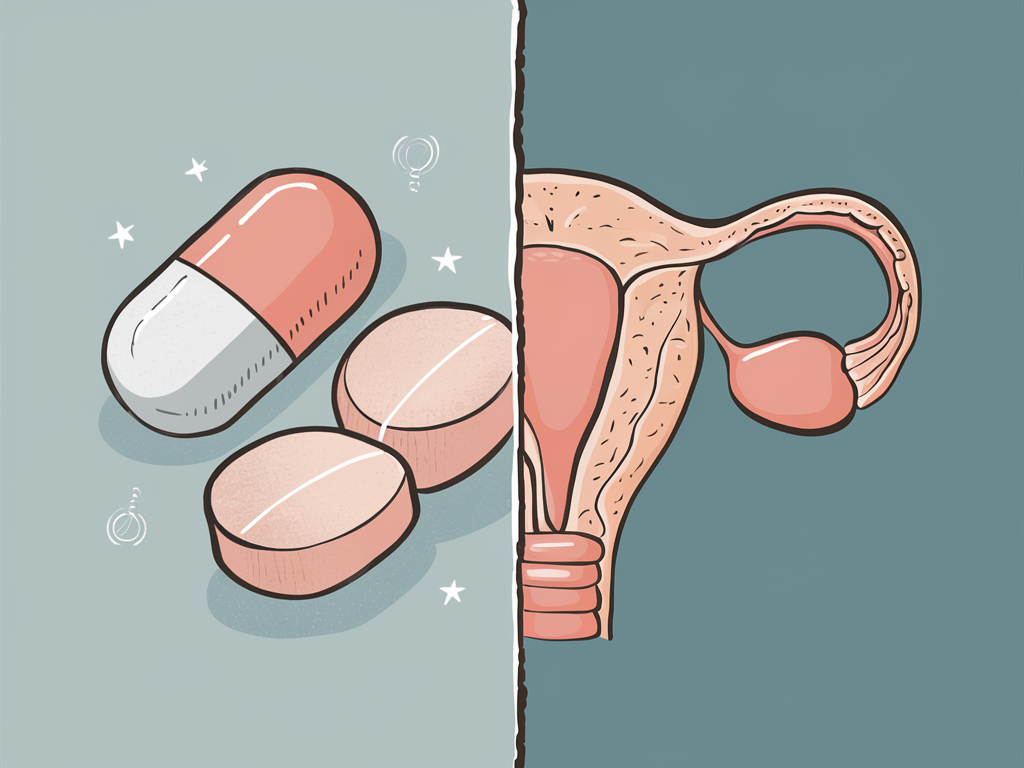Experiencing a late menstrual period can trigger worry and confusion for many women. While occasional delays are common, understanding the potential causes behind a missed period can help distinguish between normal variations and situations requiring medical attention. This comprehensive guide explores the seven most common reasons your period might be late, provides clarity on what’s considered normal, and offers guidance on when to seek professional help.
The typical menstrual cycle spans approximately 28 days, though normal cycles can range from 21-35 days. According to reproductive health studies, up to 30% of women experience irregular periods during their reproductive years. A period is generally considered “late” when it’s 5-7 days beyond its expected arrival date, though this varies based on your typical cycle length and regularity.
While occasional lateness is rarely cause for concern, persistent irregularity or significant delays may signal underlying health conditions that warrant attention. Understanding the common causes can help you determine whether your late period falls within normal variations or requires medical evaluation.

Common Reason #1: Stress
Stress represents one of the most frequent culprits behind delayed menstruation. When your body experiences psychological or physical stress, it produces elevated levels of cortisol and other stress hormones that can temporarily disrupt your hypothalamic-pituitary-ovarian axis—the communication pathway controlling your menstrual cycle.
Various types of stress can affect your period timing:
- Work-related pressure and deadlines
- Major life changes (moving, job transitions, relationship changes)
- Financial concerns
- Academic pressure or exams
- Grief or emotional trauma
- Travel and environmental changes
Stress-related menstrual delays typically resolve within one cycle after the stressful situation subsides. To help regulate your cycle during stressful periods, consider:
- Practicing mindfulness meditation or yoga
- Maintaining regular sleep patterns
- Engaging in moderate physical activity
- Seeking support through therapy or counseling
- Using relaxation techniques like deep breathing exercises
Common Reason #2: Weight Changes
Significant fluctuations in body weight—whether gain or loss—can substantially impact your menstrual cycle. Your reproductive system requires adequate body fat to maintain normal hormone production and regular ovulation.
Weight Loss Effects: Losing more than 10% of your body weight rapidly can halt ovulation and cause missed periods. This occurs because body fat is necessary for producing estrogen. When fat stores decrease significantly, estrogen levels may drop below the threshold needed to trigger ovulation and menstruation.
Weight Gain Impacts: Conversely, rapid weight gain can lead to excess estrogen production, as fat tissue converts other hormones into estrogen. This hormonal imbalance can disrupt regular ovulation and lead to irregular or missed periods.
The relationship between body composition and menstruation is particularly evident in conditions like:
- Athletic amenorrhea (absence of periods due to intense physical training)
- Eating disorders affecting nutritional status
- Obesity (BMI over 30)
Most women experience cycle normalization within 2-3 months after weight stabilization, though this varies based on individual factors and the severity of the previous weight fluctuation.
Common Reason #3: Hormonal Imbalances
Various hormonal disorders can cause menstrual irregularities, with two of the most common being:
Polycystic Ovary Syndrome (PCOS): Affecting approximately 6-12% of reproductive-age women, PCOS involves elevated androgen levels and ovarian dysfunction. Beyond irregular periods, symptoms often include:
- Excessive facial or body hair growth
- Acne or oily skin
- Thinning scalp hair
- Multiple small cysts on the ovaries (visible through ultrasound)
- Weight management challenges
Thyroid Disorders: Both hypothyroidism (underactive thyroid) and hyperthyroidism (overactive thyroid) can disrupt menstrual regularity. Additional symptoms may include:
- Unexplained weight changes
- Temperature sensitivity
- Fatigue or energy changes
- Mood alterations
- Changes in sleep patterns
Other hormonal imbalances affecting menstruation include hyperprolactinemia (elevated prolactin levels) and primary ovarian insufficiency.
Diagnostic approaches typically involve:
- Comprehensive blood tests to assess hormone levels
- Pelvic ultrasound to evaluate reproductive organs
- Thyroid function tests
- Assessment of other hormones like prolactin
Common Reason #4: Medication and Birth Control
Hormonal contraceptives are designed to alter your reproductive cycle and can significantly impact menstruation patterns:
Starting Hormonal Birth Control: When beginning hormonal contraceptives, breakthrough bleeding or missed periods are common during the first 3-6 months as your body adjusts to the new hormone levels.
Stopping Hormonal Birth Control: After discontinuing hormonal contraception, it may take 1-3 months for your natural cycle to reestablish. Some women experience post-pill amenorrhea, where periods may not return immediately after stopping birth control.
Beyond contraceptives, several other medications can potentially delay menstruation:
- Antipsychotics
- Antidepressants
- Corticosteroids
- Blood pressure medications
- Chemotherapy drugs
- Allergy medications
For most medication-related menstrual changes, your cycle should normalize within 2-3 months after adjusting to the new medication or discontinuing it (with medical supervision).

Common Reason #5: Pregnancy
Pregnancy remains the most common biological reason for a missed period in women of reproductive age. After conception, your body produces human chorionic gonadotropin (hCG), which maintains the uterine lining instead of shedding it during menstruation.
Modern home pregnancy tests can detect pregnancy with approximately:
- 75% accuracy at 6 days before your missed period
- 95% accuracy on the day of your expected period
- 99% accuracy one week after your missed period
Beyond a missed period, early pregnancy may cause additional symptoms:
- Breast tenderness or changes
- Nausea or vomiting (morning sickness)
- Increased urination frequency
- Fatigue
- Mild cramping
- Food aversions or cravings
If your period is 5-7 days late and you’ve been sexually active, taking a pregnancy test is recommended for peace of mind. For most accurate results, use first-morning urine and follow the test instructions precisely.
Common Reason #6: Perimenopause
Perimenopause—the transition phase before menopause—typically begins in a woman’s 40s, though it can start in the late 30s. During this period, fluctuating hormone levels cause menstrual cycle changes, including:
- Shorter or longer cycles
- Heavier or lighter flow
- Skipped periods
- Longer intervals between periods
Accompanying symptoms often include:
- Hot flashes or night sweats
- Sleep disturbances
- Mood changes
- Vaginal dryness
- Decreasing fertility
Perimenopause typically lasts 4-8 years before culminating in menopause (defined as 12 consecutive months without a period). During this transition, it’s still important to track cycle changes, as irregular bleeding could also indicate other health conditions requiring evaluation.
Common Reason #7: Lifestyle Factors
Various lifestyle elements can influence your menstrual cycle’s regularity and timing:
Exercise Intensity: While moderate exercise benefits reproductive health, excessive or intense training can disrupt hormonal balance. Female athletes frequently experience exercise-induced amenorrhea when body fat percentage drops too low or physical stress becomes excessive.
Travel and Time Zone Changes: Crossing multiple time zones or experiencing significant schedule disruptions can temporarily affect your circadian rhythm, which influences reproductive hormone secretion patterns. Most women notice normalization within 1-2 cycles after returning to their regular routine.
Nutritional Factors: Severely restrictive diets, nutrient deficiencies, or disordered eating patterns can all delay menstruation by affecting the hormones controlling your cycle. Key nutrients for menstrual health include:
- Iron
- Vitamin D
- B vitamins
- Omega-3 fatty acids
- Zinc
Sleep Quality: Poor sleep disrupts hormone production and regulation. Research suggests women with sleep disorders or irregular sleep patterns have a higher prevalence of menstrual irregularities. Aim for 7-9 hours of quality sleep to support reproductive hormone balance.
When To Be Concerned: Timeline Guidelines
Understanding the distinction between normal variations and concerning delays can help you determine appropriate next steps:
Normal Delay (Generally Not Concerning):
- Up to 7 days late with no additional symptoms
- Occasional irregularity (1-2 times per year)
- Expected changes during reproductive milestones (puberty, postpartum, perimenopause)
- Known factors like stress or travel
Potentially Concerning Delays:
- More than 35-40 days since your last period
- Three or more consecutive missed periods (amenorrhea)
- Sudden irregularity after previously regular cycles
- Late period accompanied by severe pain, abnormal discharge, or other worrying symptoms
Pregnancy Testing Timeline:
- Take a test when your period is 5-7 days late if pregnancy is possible
- For most accurate results, test in the morning
- Consider a second test 1 week later if the first is negative but your period remains absent
Age-Specific Considerations:
- Teens: May take 2-3 years after menarche to establish regular cycles; greater variation is normal
- 20s-30s: Should have relatively consistent cycles; unexplained changes warrant attention
- 40+: Increasing variation expected with perimenopause; but sudden severe changes still merit evaluation

When To Consult a Healthcare Provider
Seek medical evaluation if you experience:
- No period for 90+ days (with negative pregnancy tests)
- Sudden changes in cycle length or flow after previously regular periods
- Severe pain accompanying late or missed periods
- Abnormal bleeding between periods
- Missed periods along with symptoms of hormonal imbalance (excessive hair growth, acne, etc.)
- Missed periods with significant weight changes or eating disorders
- Concern about fertility
During your healthcare appointment, be prepared to discuss:
- Your complete menstrual history (regularity, cycle length, flow volume)
- Recent lifestyle changes or stressors
- Medications and contraceptive use
- Symptoms accompanying your missed or irregular periods
- Family history of reproductive disorders
Your provider may recommend various diagnostic approaches:
- Physical examination
- Blood tests for hormones (including thyroid, prolactin, androgens)
- Pelvic ultrasound
- Pregnancy testing
- Endometrial biopsy (less common, for specific concerns)
Treatment options will vary based on the underlying cause and may include:
- Hormonal medications to regulate cycles
- Lifestyle modifications
- Treatment for specific conditions like PCOS or thyroid disorders
- Nutritional support
- Stress management approaches
Conclusion
While a late period can cause anxiety, understanding that occasional delays of up to one week are typically normal can provide reassurance. Most menstrual irregularities stem from common, treatable causes like stress, lifestyle factors, or hormonal fluctuations.
Tracking your menstrual cycle using apps or a calendar can help you identify patterns and notice changes early. This information becomes invaluable when consulting healthcare providers about potential concerns.
Remember that your menstrual cycle often reflects your overall health status. Regular cycles generally indicate hormonal balance, while persistent irregularities may signal underlying issues requiring attention. By recognizing normal variations versus concerning patterns, you can make informed decisions about when to seek professional guidance for your reproductive health.
When in doubt, consulting with a healthcare provider can provide personalized guidance based on your specific health history and circumstances, ensuring that any underlying issues are addressed appropriately.

